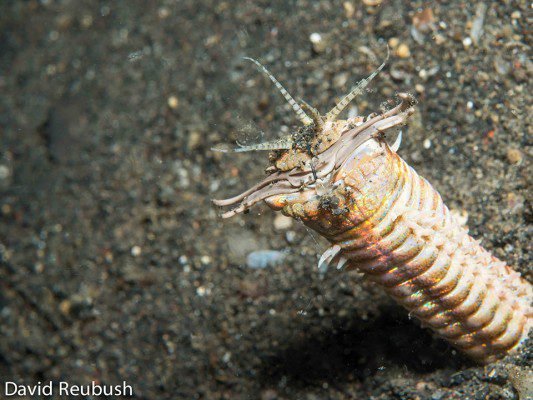
Imagine being a Bobbit worm. You’re not just waiting for your next meal; you’re also playing a crucial role in the ocean’s ecosystem. These worms, which can grow up to ten feet long, are masters of ambush. They stay buried in the sand or mud, flicking their antennae to detect prey nearby. When something delicious passes by, they strike with lightning speed. But how often does this happen? Let’s dive deeper into the fascinating feeding habits of Bobbit worms and explore what they eat, how they hunt, and how often they get to feast on their meals.
What Do Bobbit Worms Eat?
You might be wondering, **what exactly is on the menu for a Bobbit worm?** These creatures are carnivorous and have a diet that mainly consists of soft-bodied marine animals. Think of them as the ultimate hunters of the sea floor. Their favorites include:
- Small fish
- Crustaceans
- Other worms
- Various invertebrates
Here’s the thing: Bobbit worms are not picky eaters. They will take advantage of whatever comes their way. With their long, slender bodies and powerful jaws, they can catch and eat prey that is often much larger than their mouths would suggest. Picture a magician pulling a rabbit from a hat—it’s surprising, but that’s how efficient they can be!
How Often Do Bobbit Worms Eat in the Wild?
When it comes to feeding frequency, Bobbit worms don’t munch on snacks every hour, like a college student cramming for finals. Instead, their eating habits are more about quality than quantity. Bobbit worms typically eat **once every several days to weeks** depending on a few factors like availability of prey and their own metabolic rate.
Why so infrequent? Well, because they are ambush predators, they often have to wait for the right moment to strike. Each successful hunt can mean a significant energy input, so they eat less often, but when they do, they make it count. Imagine waiting for hours to catch a glimpse of a rare bird—when it finally appears, it’s worth every moment of anticipation.
Feeding Behavior: The Ambush Technique
Let’s dig into how Bobbit worms actually hunt. You might picture them as stealthy ninjas, lying in wait for their unsuspecting dinner. They camouflage themselves in the ocean floor, with only their vibrant antennae peeking out. When prey comes into range—say a curious fish or a passing crab—the worm quickly snatches it up.
Their hunting method is all about patience. Bobbit worms can remain invisible for a long time, using their antennae to sense movement in the water. When something approaches, they strike with incredible speed. By using quick, jerky movements, they can grab their meals before the prey even realizes what’s happening. It’s like when you’re playing hide-and-seek and you finally spot your friend hiding behind the couch—it’s fast, sudden, and a bit thrilling!
How Environment Affects Their Eating Habits
The environment where Bobbit worms thrive significantly influences their eating habits. These creatures are found mostly in tropical and subtropical waters, often hiding in sandy or muddy substrates. In these rich ecosystems, food availability varies greatly.
During warmer months, when the ocean is teeming with life, Bobbit worms may have more opportunities to feed. However, in colder months or during adverse weather, food can become scarce, leading to longer periods between meals. Think about it like this: if you’re at an all-you-can-eat buffet, you’re likely to eat more than if you’re stuck with a single sandwich for lunch!
The Impact of Competition and Predation
Just like any predator, Bobbit worms face competition. Other creatures in their habitat—like larger fish, crabs, or even other worms—can impact their feeding frequency. If there’s a lot of competition for food, Bobbit worms might find it harder to catch their meals, resulting in less frequent feedings.
On the flip side, they also have to be wary of predators themselves. Larger fish and certain types of birds can feast on Bobbit worms if they venture out too far from their protective burrows. So, their feeding habits are a delicate balance of risk and reward. It’s a dangerous game—they can’t eat too often or they risk being eaten, but they also can’t go too long without eating.
Bobbit Worms in Aquariums: Feeding Observations
If you’re lucky enough to keep a Bobbit worm in an aquarium, you might be curious about how their feeding habits change in a more controlled environment. Typically, aquarium owners feed their Bobbit worms every few days, sometimes even weekly. This is because, in an aquarium, there’s often a more consistent supply of food.
You can feed them:
- Small chunks of shrimp
- Fish fillets
- Specialized marine pellets
However, it’s essential to monitor how much food you provide. Too much can lead to waste and poor water quality. Imagine trying to enjoy a meal in a messy environment—it just wouldn’t be as pleasant!
Bobbit worms are more than just fascinating creatures; they play an important role in their ecosystem. Understanding how often they eat in the wild sheds light on their complex lives as both hunters and prey. Their unique feeding habits, reliant on ambush strategies, environmental conditions, and competition, make them remarkable survivors in the underwater world.
So, the next time you hear about Bobbit worms, remember: they’re not just waiting for food; they’re part of a delicate balance in the ocean that keeps everything flowing smoothly. Respect their role, and you’ll gain a deeper appreciation for the wonder that exists beneath the waves.
